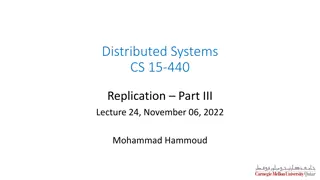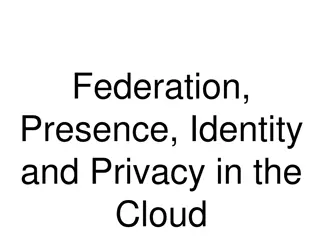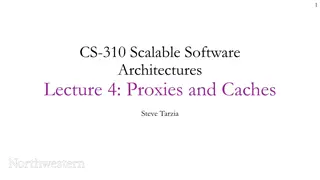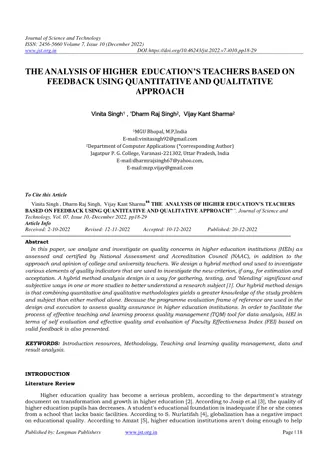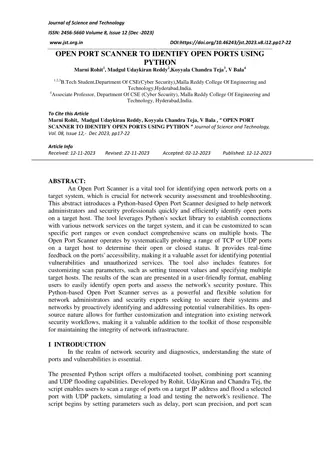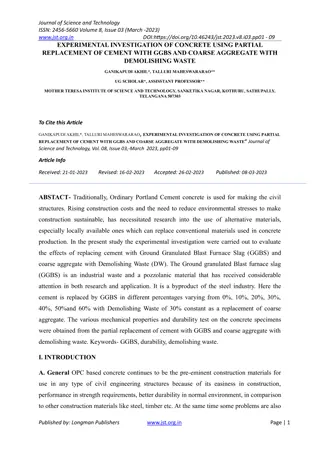Scalable Identity and Key Management for Publish-Subscribe Protocols
This research by Prashant Anantharaman from Dartmouth College focuses on scalable identity and key management for publish-subscribe protocols in Energy Delivery Systems. It discusses the architecture, goals, assumptions, and implementation results in the context of PKI vs. Macaroons protocols. The work explores key aspects of publish-subscribe protocols, including MQTT, AMQP, STOMP, and GOOSE, with insights on message routing, broker handling, and protocol implementations.
Uploaded on Oct 05, 2024 | 0 Views
Download Presentation

Please find below an Image/Link to download the presentation.
The content on the website is provided AS IS for your information and personal use only. It may not be sold, licensed, or shared on other websites without obtaining consent from the author. Download presentation by click this link. If you encounter any issues during the download, it is possible that the publisher has removed the file from their server.
E N D
Presentation Transcript
Scalable Identity and Key Management for Publish-Subscribe Protocols in EDS Prashant Anantharaman, Dartmouth College https://cs.dartmouth.edu/~pa pa@cs.dartmouth.edu Funded by the U.S. Department of Energy and the U.S. Department of Homeland Security | cred-c.org
Joint work with Kartik @ Illinois Elizabeth @ Illinois David @ Illinois Jason Sean cred-c.org | 2
Overview Introduction What are Publish-subscribe protocols? Issues in publish-subscribe protocols Contributions Proposed Architecture Goals Assumptions Our Approach PKI vs Macaroons Protocols Implementation Results and Discussion Conclusions
Publish Subscribe Protocols Producers publish messages Consumers wait for certain messages by making use of subscriptions The routing of these messages to consumers is handled by a broker Most widely used protocols include MQTT - 47,993 implementations on the internet AMQP - 194,989 implementations STOMP - 60 implementations GOOSE - ethernet layer protocol within a substation, most SEL and ABB devices come with an option to enable GOOSE Data source: shodan.io
Subscription cred-c.org | 5
Controller publishing commands cred-c.org | 6
Controller receiving data cred-c.org | 7
The MQTT Protocol Our industry partners use MQTT as a SCADA protocol. Smart meters - It is being used to enable communications between smart meters and controllers Grid control - manages control devices ranging from generators, thermostats and other sensors Our partners acknowledge the issues in MQTT implementations pointed out by us, and are working with us for a key management scheme Limited messages - connect, subscribe, unsubscribe, push Everyone subscribed on a channel will get the message No details of sender Subscribe to # TLS is optional The image is from a scan we ran using shodan.io
The MQTT Protocol (contd.) Issues identified: No senders identification Active broker compromise is an issue No real key management solution for MQTT Existing solutions talk about lightweight crypto solutions, but not key management or revocation
The MQTT Protocol (contd.) Data source: shodan.io
GOOSE Protocol Replay attacks and Spoofing attacks are very easy to perform due to the lack of identification and confidentiality mechanisms. It is an ethernet layer protocol, and all the attacks on the ethernet layer are still possible, and we can do very little to mitigate them. Packet Spoofing is a major issue, since GOOSE ignores packets based on SqNum field. In case the packet is less than the SqNum field in the previous spoofed packet, it is ignored, leading to several packets to be ignored.
Contributions We provide results from measurements of the authentication (or lack thereof) of publish-subscribe protocols appearing on the internet. Demonstrate the effectiveness of our macaroon-based key management scheme in the context of publish-subscribe schemes. We built a toolkit for our scheme, and run experiments on an implementation of MQTT. We show that in terms of CPU- time and developer effort, our systems performs well within the acceptable latency bounds. cred-c.org | 12
Overview Introduction What are Publish-subscribe protocols? Issues in publish-subscribe protocols Contributions Proposed Architecture Goals Assumptions Our Approach PKI vs Macaroons Protocols Implementation Results and Discussion Conclusions
Goals Build a system resilient to active server compromises Assign separate keys for long lasting assertions like the identity, and short lasting ones like accesses to channels Broker doesn t see any raw messages, and hence any clients connected without keys won t see them either In case of device compromise, only the channels the device has access to are compromised Release the toolkit for the controller and the individual devices
Assumptions We can install keys securely during deployment of a device The cryptographic primitives are bug-free The devices can securely store the identity and attribute channel specific keys
Our Approach Each device has two kinds of identities - A core identity - installed either during manufacturing or during deployment. Association attributes - one macaroon per channel. These are shorter lived, and need to be changed frequently. An attribute can be formalized as a tuple (P,O, ). Property P holds for Object O for Time . The core identity assertions are made by the manufacturer or deployer, and are verified by the controller. The attribute assertions are made by the controller, when provided with the identity assertion. cred-c.org | 16
Macaroons A macaroon consists of two parts A public part: consisting a random nonce and a set of caveats A secret part: the final HMAC value generated by iteratively computing the HMAC on individual caveats. This secret is used as a shared secret to compute subsequent session keys
Our scheme in the lifecycle of a device in EDS cred-c.org | 20
Who makes the assertions? cred-c.org | 21
Who makes the assertions? cred-c.org | 22
Who makes the assertions? (contd.) cred-c.org | 23
Session Keys We make use of the J-PAKE algorithm to establish a session key between the device and the controller The J-PAKE algorithm is resilient to Known-key attacks, online and offline dictionary attacks, and provides forward secrecy It generates a high entropy cryptographic key from a low entropy secret This session key is then used to set up the channel specific macaroons cred-c.org | 24
Short Lived Macaroons cred-c.org | 25
Operation cred-c.org | 26
Revocation The short-lived keys expire soon, and are subsequently blacklisted. When the channel keys to a particular device need to be revoked, the channel keys given to all the other devices with access to the channel are also revoked. Hence, there is a list maintained of what devices are connected to what channels. A whitelist of all the manufacturer keys is maintained, so that the macaroons can be verified, and session keys can be generated from the verified macaroons. cred-c.org | 27
Overview Introduction What are Publish-subscribe protocols? Issues in publish-subscribe protocols Contributions Proposed Architecture Goals Assumptions Our Approach PKI vs Macaroons Protocols Implementation Results and Discussion Conclusions
Implementation The device and the controller have been implemented in ruby. Web Server in Ruby on Rails is a work in progress. We made use of Mosquitto MQTT Broker and client off-the-shelf, and built our layer of security on top of it.
Verification We made use of Proverif 1.98pl1 to verify our cryptographic protocol. We were able to prove that the shared secret k used in the session key establishment, is never leaked by the protocol.
Overview Introduction What are Publish-subscribe protocols? Issues in publish-subscribe protocols Contributions Proposed Architecture Goals Assumptions Our Approach PKI vs Macaroons Protocols Implementation Results and Discussion Conclusions
Preliminary Results Our experiments were performed on an ARM Firefly RK3288 development board. The GOOSE protocol has a prescribed maximum latency of 4ms. Since all the other schemes make use of elliptic curves, we show that elliptic curves are highly infeasible for such constrained devices and show that macaroons are much more usable. Algorithm Creation time Verification time Elliptic Curves Ed25519-256 bits 25.79 ms 29.34 ms Macaroons SHA-1-HMAC 662 s 513 s SHA-256-HMAC 761 s 566 s
Developer Effort The device specific programs would have to be instrumented with our macaroon generation and verification protocols. In our experimental setup, we only had to add 20 lines of ruby code to the device clients for MQTT. The biggest development effort in similar architectures, is re-creating the MQTT broker. Our scheme does not require any broker changes.
Overview Introduction What are Publish-subscribe protocols? Issues in publish-subscribe protocols Contributions Proposed Architecture Goals Assumptions Our Approach PKI vs Macaroons Protocols Implementation Results and Discussion Conclusions
Conclusions and Future work We built a system that meets our latency and security goals We intend to release our tool by June 2018 Future work: Integrating into the shared secret option of SSP21 protocol Working with GE to incorporate our scheme into their MQTT ecosystem We are also in talks with another potential industrial partner and already had a few initial discussions
Thank you Toolkit will be available soon. Prashant Kartik Elizabeth Jason Sean pa@cs.dartmouth.edu palani2@illinois.edu ereed@illinois.edu reeves@cs.dartmouth.edu sws@cs.dartmouth.edu cred-c.org | 36
http://cred-c.org @credcresearch facebook.com/credcresearch/ Funded by the U.S. Department of Energy and the U.S. Department of Homeland Security











